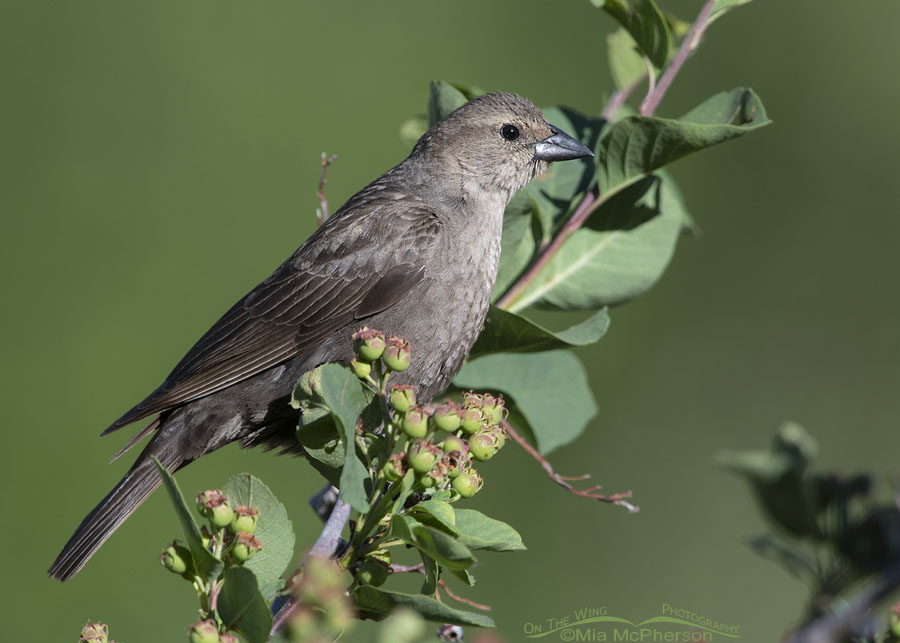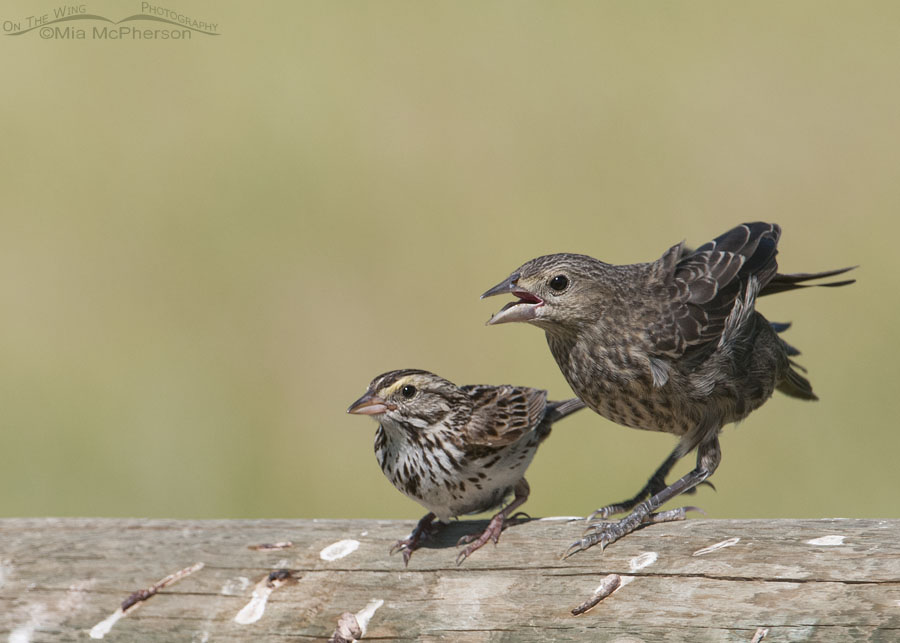 Female Brown-headed Cowbird perched in a Utah Serviceberry – Nikon D500, f7.1, 1/640, ISO 500, Nikkor 500mm VR with 1.4x TC, natural light
Female Brown-headed Cowbird perched in a Utah Serviceberry – Nikon D500, f7.1, 1/640, ISO 500, Nikkor 500mm VR with 1.4x TC, natural light
Yesterday I mentioned that the adult Song Sparrows that are nesting high in the Wasatch Mountains have been busy chasing away other birds that have gotten near their nest and that it has been interesting to observe their behaviors. Three days ago one of the birds that the Song Sparrows chased off was an adult female Brown-headed Cowbird that landed on a serviceberry in front of me.
I know that some people despise Brown-headed Cowbirds, I don’t.
Native Brown-headed Cowbirds have bad reputations as brood parasites which means the female cowbirds lay their eggs in the nests of other birds and their young when hatched by the host species out compete their young which can mean fatalities of the host species chicks. That sounds grim and it is, especially since the cowbirds expanded their range to the east when historically they used to live primarily in the Great Plains.
These “Buffalo Birds” expanded their ranges in all directions during the 19th and 20th centuries during a time period when humans were cutting down the forests to the east, west, north and south of the Great Plains. Cowbirds typically avoid heavily forested areas but once those forests were chopped down and the lands that used to be forested became open fields, farm lands and residential areas it made it easier for these birds to expand their range.
Some of the birds here in the west have adapted to brood parasites. If Yellow Warblers find a cowbird egg in their nest they build a new nest right over top of the cowbird egg and lay more eggs of their own and the cowbird egg never hatches because it isn’t incubated. Other birds recognize the cowbird eggs and destroy them but a large portion of the 220+ host species don’t.
Maybe the Song Sparrows chased off the female Brown-headed Cowbird three days ago because they didn’t want her laying an egg in their nest? I don’t know for sure, the sparrows probably laid their eggs more than a week ago.
 Adult Savannah Sparrow with fledgling Brown-headed Cowbird – Nikon D300, f9, 1/800, ISO 500, Nikkor 200-400mm VR with 1.4x TC at 400mm, natural light
Adult Savannah Sparrow with fledgling Brown-headed Cowbird – Nikon D300, f9, 1/800, ISO 500, Nikkor 200-400mm VR with 1.4x TC at 400mm, natural light
I spend a great deal of time in the field and I’ve only seen Brown-headed Cowbird fledglings with their “host” parents a few times. I’ve photographed interactions between cowbird fledglings and “host” Savannah Sparrow adult at Red Rock Lakes NWR in Montana. The Brown-headed Cowbird fledgling ran the adult sparrow nearly ragged trying to find enough food to satisfy the young bird’s bottomless appetite.
I find Brown-headed Cowbirds to be as fascinating as any other bird I photograph and when I have them in my viewfinder I don’t spend a moment of my time thinking about them being brood parasites. I am focused on taking photos of them.
Life is good. Stay safe.
Mia
Click here to see more of my Brown-headed Cowbird photos plus facts and information about this species.


Great study Mia. I was particularly interested in the commentary offered by your other contributors. Wonderful photos too. Thanks.
I read April’s comment about Cowbirds being hardwired to recognize their own kind. Very interesting.
That would be exhausting to feed a birdt that size. Is there a point where the fledgling cowbirds return to their own species to learn the calls,and nbod with their real parents?
Jane,
This is a list of how many times per hour a “host” feeds cowbird young:
Parental Care
Provided by host species. Feeding rates to cowbird fledglings vary, depending on host species, but always higher than feeding rate for hosts’ own young (Woodward 1983): 22 feeds/h, Eastern Phoebe; 33/h, Acadian Flycatcher (Empidonax virescens); 10–15/h, Carolina Wren (Thryothorus ludovicianus); 8/h, Eastern Bluebird (Sialia sialis); 73/h, Blue-gray Gnatcatcher (Polioptila caerulea); 36/h, Common Yellowthroat (Geothlypis trichas); 8/h, Northern Cardinal (Cardinalis cardinalis); 16/h, Song Sparrow.
I would say that by fall or migration the young cowbirds start to associate with their own species and that may be when they learn to call like the adults. As far as bonding with their real parents, I don’t find any evidence that it happens.
It is an interesting adaptation. I find it fascinating that some birds recognise the intruders and other’s don’t. Building a new nest on top of the old is an innovative response.
Thank you (again) for continuing my education.
My pleasure EC!
Cowbirds are very interesting once you get to know them. We have been lucky to have worked with a few and observe their behavior. One trait we were fascinated with is imprinting .Birds imprint on the parents who feed them, that is why in wildlife rehab we make every effort for the baby birds to not see the humans caring for them. Rehabilitators don’t want them to see humans as their kind and imprint on humans rather than their own species. If the cowbird is raised by another bird species, how does it recognize it’s own kind for mating? The cowbirds seem genetically hardwired to recognize their own kind.
I seem to remember watching a PBS program about sage grouse that included a short section on cowbirds. If I recall correctly they followed a cow bird both laying eggs in another nest and also raising a nest of its own. I will have to look for the program and watch it again.
April,
I think cowbirds are interesting, I can imagine that they would be even more so working with them.
I found this while searching for the times per hour a “host” feeds young cowbirds:
“West et al. (West et al. 1981) conclude that cowbirds have an innate species recognition component included in aspects of male song. Isolated male cowbirds will develop a “normal” song to which females show an innate preference, of obvious selective advantage for a parasitic species. Flight whistle acquired during a male’s first breeding season.”
So I would assume the ability to recognize their own species despite being raised by a “host” species is hard-wired into their brains.
Not my favorite bird, last year I had a first when I saw a male Cardinal feeding a cowbird chick and so far this year, I have had a chipping sparrow feeding one in my yard.
Rosemary, I suspect the adult Chipping Sparrows are working extremely hard to keep the young cowbird in your yard fed!
Cool photos Mia
Thanks Bob.
I know that Brown-headed Cowbirds are parasitic but do they ever have their own nest? I have a photo of a male Brown-headed Cowbird with a fledgling that it was feeding. I also saw another male with 2 fledglings. Same spot but a year apart. I never saw a female.
Liz, I checked birdsoftheworld.org (formally Birds of North America) and they indicate that Brown-headed Cowbirds do not build nests or provide any parental care of the young so your observations are unusual and unique. And fascinating!